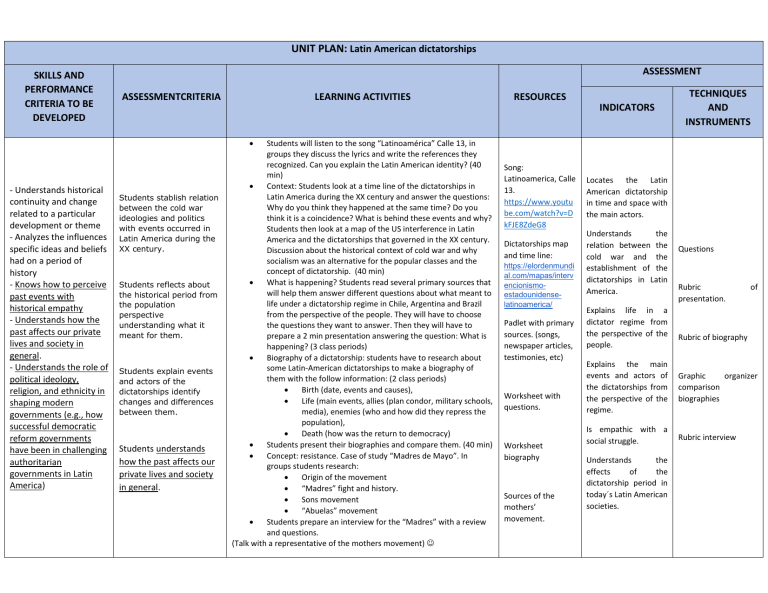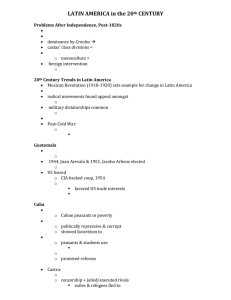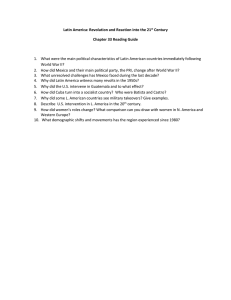
UNIT PLAN: Latin American dictatorships SKILLS AND PERFORMANCE CRITERIA TO BE DEVELOPED ASSESSMENT ASSESSMENTCRITERIA LEARNING ACTIVITIES RESOURCES INDICATORS TECHNIQUES AND INSTRUMENTS - Understands historical continuity and change related to a particular development or theme - Analyzes the influences specific ideas and beliefs had on a period of history - Knows how to perceive past events with historical empathy - Understands how the past affects our private lives and society in general. - Understands the role of political ideology, religion, and ethnicity in shaping modern governments (e.g., how successful democratic reform governments have been in challenging authoritarian governments in Latin America) Students stablish relation between the cold war ideologies and politics with events occurred in Latin America during the XX century. Students reflects about the historical period from the population perspective understanding what it meant for them. Students explain events and actors of the dictatorships identify changes and differences between them. Students understands how the past affects our private lives and society in general. Students will listen to the song “Latinoamérica” Calle 13, in groups they discuss the lyrics and write the references they recognized. Can you explain the Latin American identity? (40 min) Context: Students look at a time line of the dictatorships in Latin America during the XX century and answer the questions: Why do you think they happened at the same time? Do you think it is a coincidence? What is behind these events and why? Students then look at a map of the US interference in Latin America and the dictatorships that governed in the XX century. Discussion about the historical context of cold war and why socialism was an alternative for the popular classes and the concept of dictatorship. (40 min) What is happening? Students read several primary sources that will help them answer different questions about what meant to life under a dictatorship regime in Chile, Argentina and Brazil from the perspective of the people. They will have to choose the questions they want to answer. Then they will have to prepare a 2 min presentation answering the question: What is happening? (3 class periods) Biography of a dictatorship: students have to research about some Latin-American dictatorships to make a biography of them with the follow information: (2 class periods) Birth (date, events and causes), Life (main events, allies (plan condor, military schools, media), enemies (who and how did they repress the population), Death (how was the return to democracy) Students present their biographies and compare them. (40 min) Concept: resistance. Case of study “Madres de Mayo”. In groups students research: Origin of the movement “Madres” fight and history. Sons movement “Abuelas” movement Students prepare an interview for the “Madres” with a review and questions. (Talk with a representative of the mothers movement) Song: Latinoamerica, Calle 13. https://www.youtu be.com/watch?v=D kFJE8ZdeG8 Dictatorships map and time line: https://elordenmundi al.com/mapas/interv encionismoestadounidenselatinoamerica/ Padlet with primary sources. (songs, newspaper articles, testimonies, etc) Worksheet with questions. Worksheet biography Sources of the mothers’ movement. Locates the Latin American dictatorship in time and space with the main actors. Understands the relation between the cold war and the establishment of the dictatorships in Latin America. Explains life in a dictator regime from the perspective of the people. Questions Rubric presentation. of Rubric of biography Explains the main events and actors of the dictatorships from the perspective of the regime. Graphic organizer comparison biographies Is empathic with a social struggle. Rubric interview Understands the effects of the dictatorship period in today´s Latin American societies.


